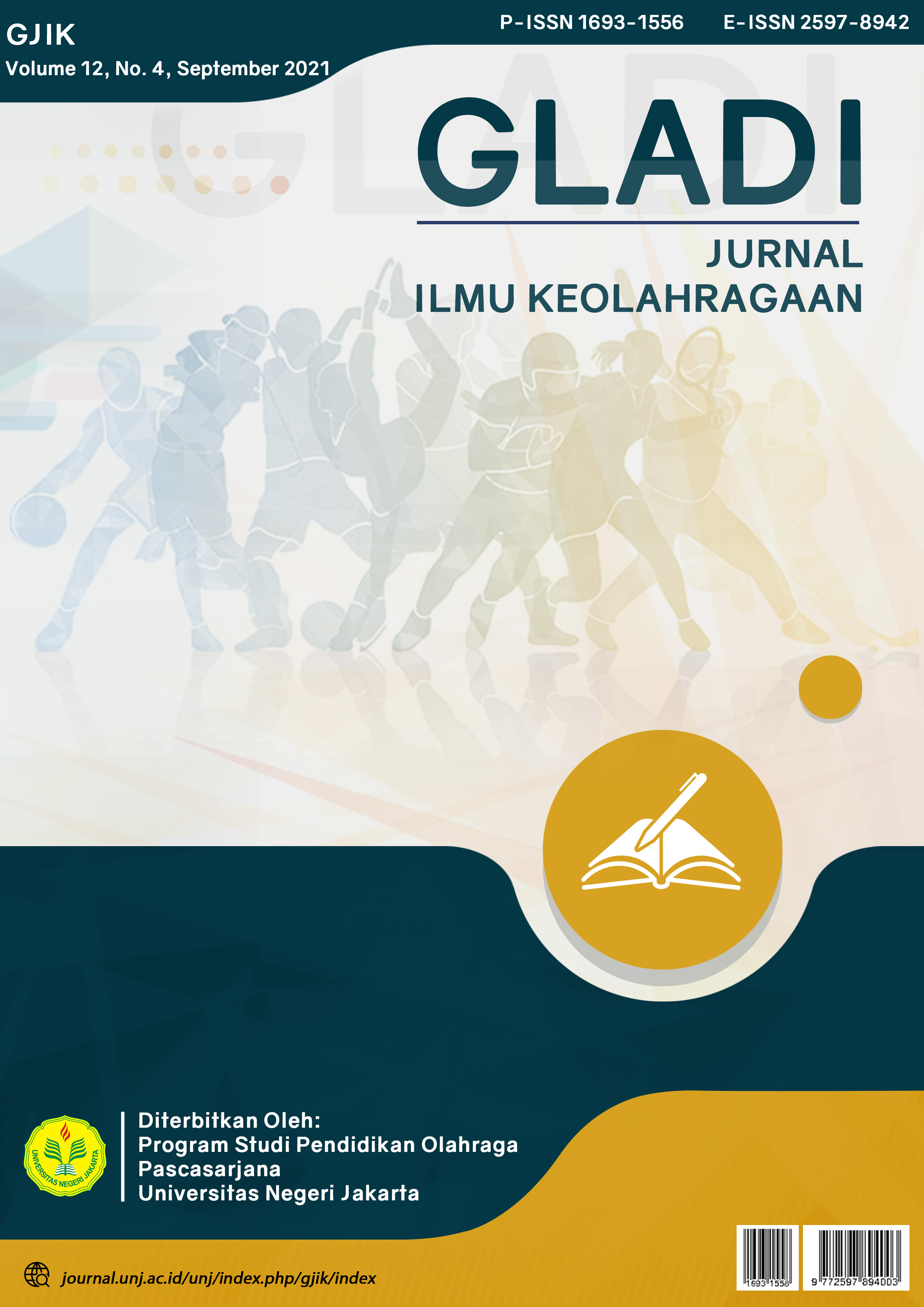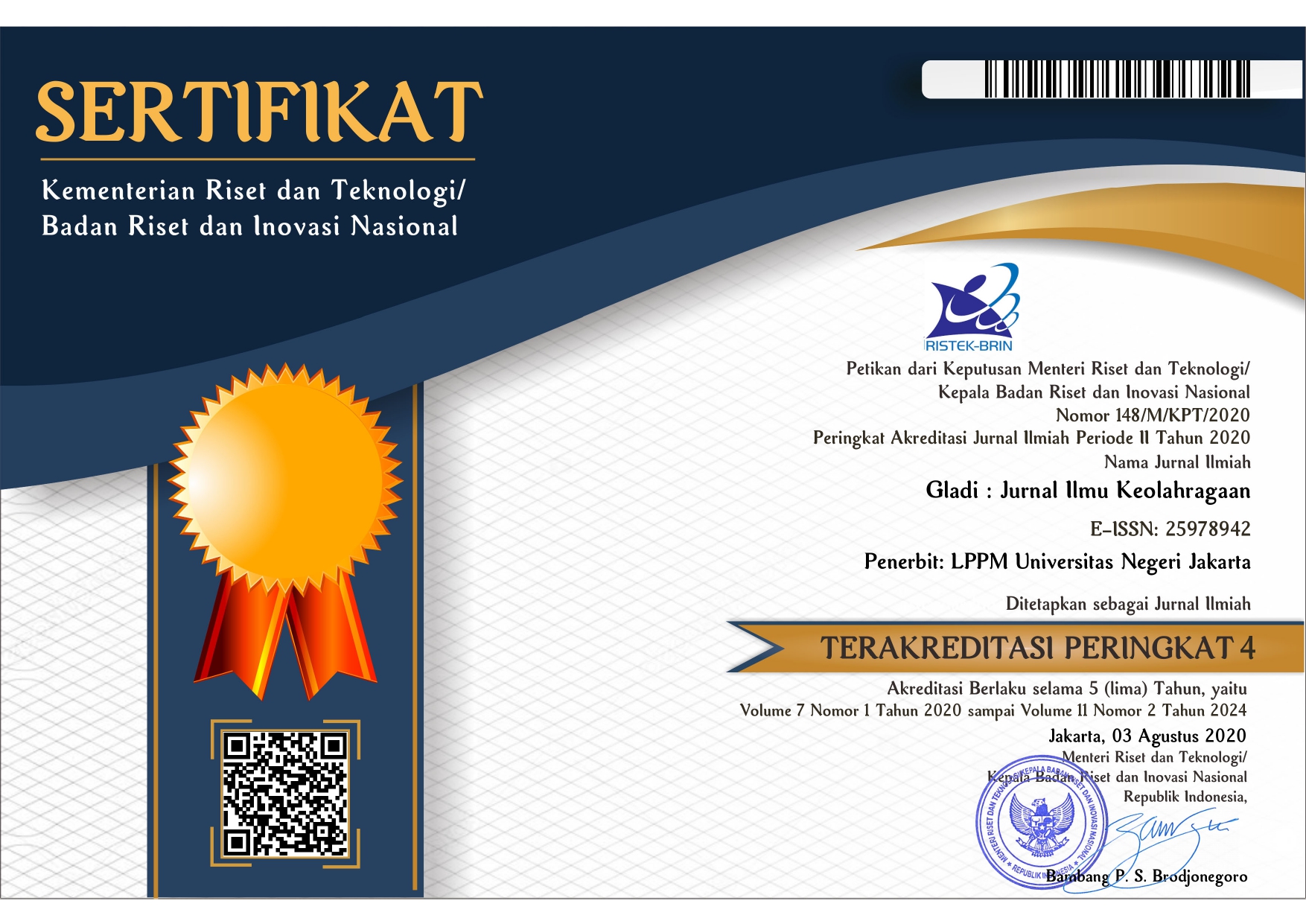GAME-BASED BACKHAND TENNIS TECHNIQUE LEARNING MODEL TO IMPROVE LEARNING OUTCOMES
DOI:
https://doi.org/10.21009/GJIK.124.06Keywords:
Learning Model; Backhand Tennis; Games; Learning OutcomesAbstract
The purpose of this study is to find out a learning model using a game-based tennis backhand skill model. The method used is Research & Development with mixed methods research approach that combines qualitative and quantitative methods. It is intended to be able to reach or process all data or information so that a comprehensive explanation will be obtained. The number of samples as many as 20 respondents. The steps taken in the trial include: (1) establishing a group of research subjects (2) Carrying out Pretest (3) trying the model that has been developed (4) carrying out post-test (5) looking for the average score of pretest and posttest and compared between the two (6) looking for the differences between the two averages through statistical methods (t-test) to find out whether or not there is a significant influence of the use of the model. The conclusion of this study is that game-based tennis backhand learning model can be developed and applied in the process of learning backhand techniques of tennis effectively and efficiently.
Downloads
References
Alexandros, M., Christina, K., Nikolaos, G., & Konstantinos, M. (2013). Effectiveness of backhand with one and two hands in teaching adult men beginners in tennis. Journal of Physical Education and Sport, 13(3), 415–418. https://doi.org/10.7752/jpes.2013.03066
Arisman, A., & Noviarini, T. (2021). Tabata Workout dalam Meningkatkan Kebugaran Atlet Panahan. Halaman Olahraga Nusantara (Jurnal Ilmu Keolahragaan), 4(1), 12–22.
Brown, J. (2013). Tennis : Steps to Success Fourth Edition (4 ed.). USA: Human Kinetics.
Elliott, B., Marsh, A. P., & Overheu, P. (1989). The Topspin Backhand Drive in Tennis- a Biomechanical Analysis. Journal of Human Movement Studies, 16(1), 1–16.
Genevois, C., Reid, M., Rogowski, I., & Crespo, M. (2014). Performance factors related to the different tennis backhand groundstrokes: A review. Journal of Sports Science and Medicine, 14(1), 194–202.
Hidayat, R. (2018). Game-Based Learning: Academic Games sebagai Metode Penunjang Pembelajaran Kewirausahaan. Buletin Psikologi, 26(2),71. https://doi.org/10.22146/buletinpsikologi.30988
Iwatsuki, T., Takahashi, M., & Van Raalte, J. L. (2016). Effects of the intention to hit a disguised backhand drop shot on skilled tennis performance. International Journal of Sports Science and Coaching, 11(3), 365–373. https://doi.org/10.1177/1747954116644063
King, M. A., Kentel, B. B., & Mitchell, S. R. (2012). The effects of ball impact location and grip tightness on the arm, racquet and ball for one-handed tennis backhand groundstrokes. Journal of Biomechanics, 45(6), 1048–1052. https://doi.org/10.1016/j.jbiomech.2011.12.028
Kinnerk, P., Harvey, S., MacDonncha, C., & Lyons, M. (2018). A Review of the Game-Based Approaches to Coaching Literature in Competitive Team Sport Settings. Quest, 70(4), 401–418. https://doi.org/10.1080/00336297.2018.1439390
Musthofa, B., Subroto, T., & Budiana, D. (2016). Implementasi Pendekatan Bermain Dalam Pembelajaran Aktivitas Berlari The Implementation of Play Approach in Run Activity Learning. 1(1), 48–56. https://doi.org/10.17509/jpjo.v1i1.3663
Okilanda, A., Dlis, F., Humaid, H., Putra, D. D., Arisman, A., & Muslimin, M. (2021). Defense Warm-Up Exercise Material for 13-Age Athlete Using Video Technology in Covid-19 Era. International Journal of Human Movement and Sports Sciences, 9(4), 629–634. https://doi.org/10.13189/saj.2021.090404
Prasetyo, K. (2016). Penerapan Pendekatan Bermain Untuk Meningkatkan Hasil Belajar Lompat Jauh Gaya Jongkok Pada Siswa Kelas 5 Sekolah Dasar. Scholaria : Jurnal Pendidikan dan Kebudayaan, 6(3), 196. https://doi.org/10.24246/j.scholaria.2016.v6.i3.p196-205
Reid, M., Elliott, B., & Crespo, M. (2013). Mechanics and learning practices Associated with the Tennis forehand: A review. Journal of Sports Science and Medicine, 12(2), 225–231.
Roy, F. seff, Marison, W., & Wijaya, Y. S. (2017). Tingkat Keberhasilan Groundstroke Forehand Dan Backhand Pemain Tim Nasional Tenis Lapangan Indonesia Pada Pertandingan Davis Cup Antara Indonesia Vs Vietnam Maret 2016 Di Solo. JSCE - Jurnal ilmiah Sport Coaching and Education, 1(1), 29–43. https://doi.org/https://doi.org/10.21009/JSCE.01103
Siahaan, D. (2017). Perbedaan pengaruh latihan horizontal swing dan latihan side laeral raise terhadap power otot lengan dalam permainan tenis lapangan.1(2),99–108. https://doi.org/https://doi.org/10.24114/jp.v1i2.8060
Stanbrough, M. (2012). The Games Approach: Having Fun while Accomplishing Goals. jornal of coaching education, 5(2), 78–92. https://doi.org/https://doi.org/10.1123/jce.5.2.78
Sukadiyanto, S. (2005). Prinsip-Prinsip Pola Bermain Tenis Lapangan. Jurnal Olahraga Prestasi, 1(2), 261–281.
Wibowo, R. A. T. (2017). Perbedaan Pengaruh Model Pembelajaran Berganti Dan Backhand Tenis Lapangan Ditinjau Dari Koordinasi Mata-Tangan. Jurnal Ilmiah PENJAS, 3, No.2(2, ISSN : 2442-3874), 11–26.







